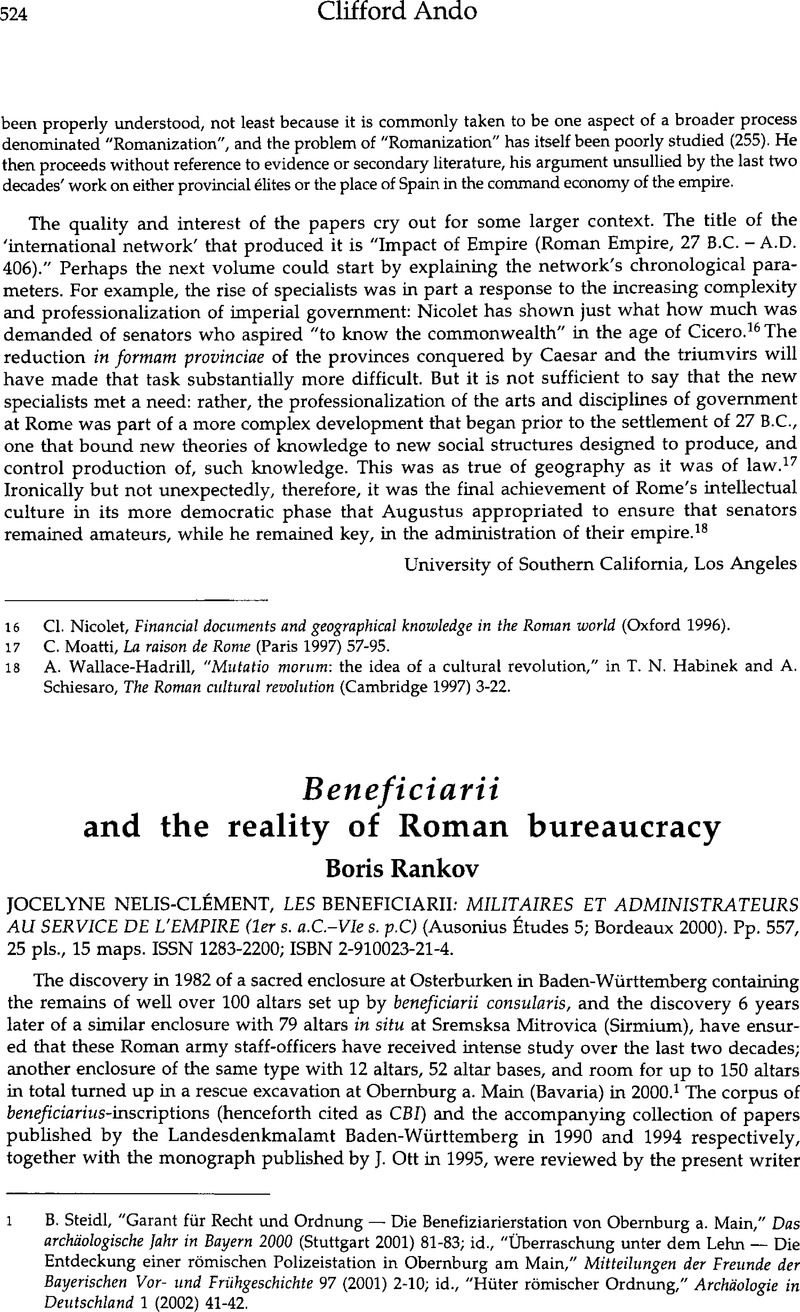No CrossRef data available.
Article contents
Beneficiarii and the reality of Roman bureaucracy - Jocelyne Nelis-Clément, LES BENEFICIARII: MILITAIRES ET ADMINISTRATEURS AU SERVICE DE L'EMPIRE (1er s. a.C.–VIe s. p.C) (Ausonius Études 5; Bordeaux 2000). Pp. 557, 25 pls., 15 maps. ISSN 1283-2200; ISBN 2-910023-21-4.
Published online by Cambridge University Press: 16 February 2015
Abstract

- Type
- Reviews
- Information
- Copyright
- Copyright © Journal of Roman Archaeology L.L.C. 2002
References
1 Steidl, B., “Garant für Recht und Ordnung — Die Benefiziarierstation von Obernburg a. Main” Das archäologische Jahr in Bayern 2000 (Stuttgart 2001) 81–83 Google Scholar; id., “Überraschung unter dem Lehn — Die Entdeckung einer römischen Polizeistation in Obernburg am Main” Mitteilungen der Freunde der Bayerischen Vor- und Frühgeschichte 97 (2001) 2-10; id., “Hüter römischer Ordnung” Archäologie in Deutschland 1 (2002) 41-42.
2 Rankov, B., “ Beneficiarii (military staff officers) and the discoveries at Osterburken” JRA 12 (1999) 675-81Google Scholar, reviewing Schallmayer, E. et al. (edd.), Oer römische Weihebezirk von Osterburken I. Corpus der griechischen und lateinischen Beneficiarier-Inschriften des römischen Reiches (Stuttgart 1990)Google Scholar, Der römische Weihebezirk von Osterburken II. Kolloquium 1990 und paläobotanische-osteologische Untersuchungen (Stuttgart 1994), and Ott, J., Die Beneficiarier. Untersuchungen zur ihrer Stellung innerhalb der Rangordnung des römischen Heeres und zu ihrer Funktion (Historia Einzelschriften 92, 1995)Google Scholar.
3 Mirković, M., “Beneficiarii consularis in Sirmium,” Chriron 24 (1994) 345–404 Google Scholar.
4 Haensch, R., review of CBI in BJb 195 (1995) 800-19Google Scholar.
5 Cauer, E., “De muneribus militaribus centurionatu inferioribus,” Ephemeris Epigraphica 4 (1881) 355-481, esp. 379–401 Google Scholar.
6 K. Eibl, “Gibt es eine spezifische Ausrüstung der Beneficiar ier?” in Der römische Weihebezirk (supra n.2) 273-97.
7 For example, the chapter entitled “Government without bureaucracy” in Garnsey, P. and Sailer, R. P., The Roman empire. Economy, society and culture (London 1987) 20–40 Google Scholar; cf. Posner, E., Archives in the ancient world (Cambridge, MA 1972) 160-85CrossRefGoogle Scholar; Beard, M., “Writing and ritual: a study of diversity and expansion in the Arval Acts,” PBSR 53 (1985) 114-62Google Scholar; Purcell, N., “The arts of government,” in Boardman, J. et al. (edd.), The Oxford history of the classical world (Oxford 1986) esp. 580 ff.Google Scholar; Culham, P., “Archives and alternatives in Republican Rome” CP 84 (1989) 100-15Google Scholar; Purcell, N., “Atrium libertatis,” PBSR 61 (1993) esp. 140-42Google Scholar.




